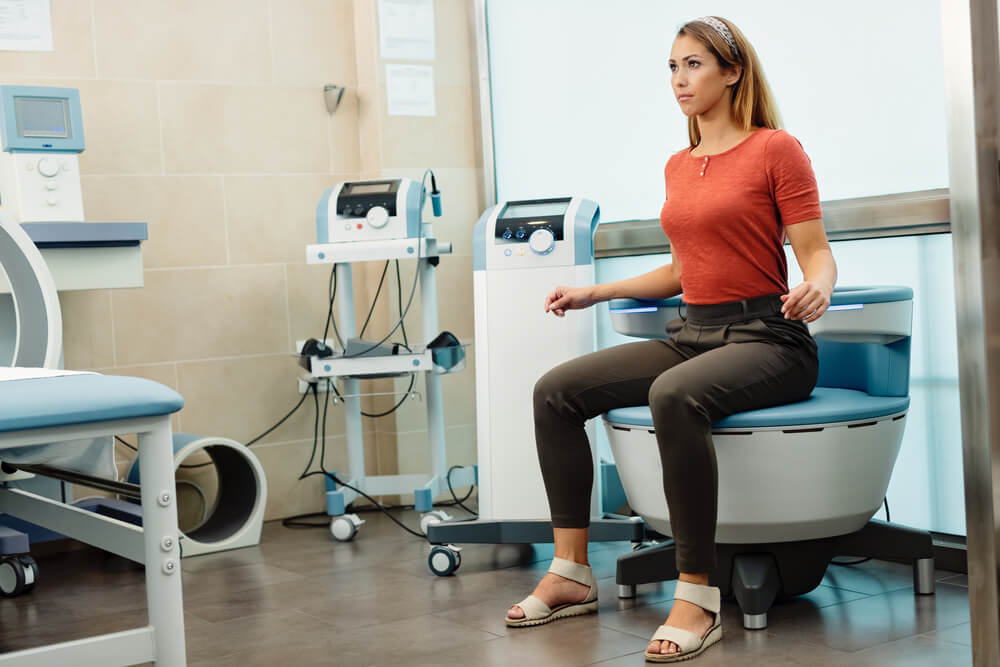When you think about strengthening your core, you most likely aren’t thinking about strengthening the muscles within your pelvis. These often unnoticed groups of muscles perform valuable functions for our bodies. A great way to ensure that they are solid and perform optimally is by participating in pelvic floor therapy.
This type of therapy aims to strengthen, stretch, and coordinate the muscles of the pelvis, which are the base of the core system of muscles.
Signs of a Weak Pelvic Floor
Just like having weak bicep muscles can make lifting a heavy object difficult, having weak pelvic muscles can negatively affect your body’s daily functions. Since this body part is responsible for holding up your bladder and reproductive organs, the issues caused by dysfunction here can be particularly frustrating.
Symptoms of weakness may include:
- Urinary or fecal incontinence
- Leaking of gas or urine during movement
- Pain/discomfort during intercourse or a lack of sensation
- Recurrent Urinary Tract Infections
- Heaviness inside the pelvis
These side effects result from an inability to properly contract and relax the muscles in the pelvis and likely indicate either overly tense or overly relaxed muscles. If you are experiencing issues like this, that is a good indicator that you would benefit from pelvic floor physical therapy.
Pelvic Floor Weakness and Pregnancy

Many women ignore or treat pelvic floor weakness as an unavoidable side effect of experiencing pregnancy, labor, and delivery. However, with proper care and exercise, women who have given birth are typically able to regain full muscle and tendon control and avoid common issues such as urinary leaking or pain during intercourse.
Women who are currently pregnant or plan to become pregnant soon can benefit from pelvic floor PT as well because it can make the labor process easier. PT helps mothers gain better control over the muscles involved in vaginal birth to reduce perineal tears and allow for a more swift recovery postpartum.
How Can Pelvic Floor PT Help?
In practice, pelvic floor PT is a combination of several different methods of solving the issues mentioned above, and those methods are:
- Determining the root of the problem
- Educating patients about their bodies
- Providing exercise plans
- Providing tools and resources for further instruction and aide
Determining the Root of the Problem
Pelvic floor therapy first looks to determine the reason that the pelvic muscles have been weakened to properly correct the issue if necessary. As previously mentioned, pregnancy and labor are common causes of pelvic floor dysfunction. Other causes include:
- Obesity
- Straining related to constipation
- Excessive coughing
- Surgeries that cut into the tissues in the area
- Hormonal imbalances from menopause
- Conditions that cause painful periods and strain
Any activity that puts continual or prolonged stress on specific body parts can lead to deterioration or improper functioning. Pelvic floor muscle dysfunction is more difficult to notice because we typically don’t recognize when we use these muscles the same way we would recognize when using our arm or leg muscles.
This is why it is important to take time and assess habits and lifestyle choices that could inadvertently cause damage to our bodies and work to correct them.
Teaching Proper Methods of Pelvic Floor Care
Once your therapist has helped you determine possible causes, pelvic floor physical therapy employs the tool of education. The practitioner explains different habits that can help improve the functioning of your muscles over time and counteract some of the strain caused by the root problem. This education may be in the realm of hygiene, posture, or overall bodily health.
This education often helps you directly combat the issue to become less persistent and more manageable. In a situation where obesity, constipation, or coughing contributes to the weakness, additional medical assistance may be helpful to lessen its impacts on your pelvic floor.
Exercising the Pelvic Floor
Your pelvic therapist can also create a therapy plan to correct the problem. Pelvic floor treatments often include guided exercises to train the pelvic muscles to contract and relax at the appropriate times. If necessary, your pelvic therapist can also perform manual therapy or massages to relax particularly tight muscles and assist with stretching.
The exercises that make up the treatment plan will often be specific to the areas of weakness and issues experienced. Prescribed exercises should be practiced in between sessions to be most effective. With consistent practice, many patients note significant improvement.
Providing Tools and Resources for Therapy
Pelvic therapists also have access to tools and resources that can help build mental connections and allow clients to gain better muscle control. For example, they can use pelvic floor biofeedback probes to help patients see which muscles they need to be exercising. Also, they can use mild electrical stimulation to assist the proper muscles in contracting so that the patient can build a mind-muscle connection and perform the movement on their own.
Another tool that may be a part of pelvic floor treatments is vaginal dilators, which the patient uses to stretch overly tight muscles inside the vagina over time. Using tools like this in conjunction with an exercise plan can significantly reduce painful symptoms associated with pelvic floor dysfunction.
One of the most interesting tools that we employ at South Miami OB-GYN Associates is laser rejuvenation technology, which can enhance the strength and control that you have over your vaginal muscles. The treatment is able to reduce troublesome issues like urinary incontinence and pain or insensitivity during intercourse.
What to Expect at a Pelvic Floor PT Appointment

Entering your first therapy session can be frightening, and it is difficult to know what to expect, even if you have done your research. That’s why when you book a pelvic floor physical therapy appointment with TopLine MD, we make sure that you are treated in a calming environment by a professional and friendly practitioner who is prepared to answer all of your questions and help you discover the best treatment plan for you.
We do our best to provide a variety of treatment options so that you can discover what works best to alleviate your symptoms and feel as comfortable as possible. Our therapists are prepared to work with patients looking to heal and strengthen weakened pelvic muscles as well as those looking to prepare their bodies for pregnancy and labor.
If you would like to find out more about receiving pelvic floor physical therapy, please give us a call or schedule an appointment with one of our excellent practitioners.




